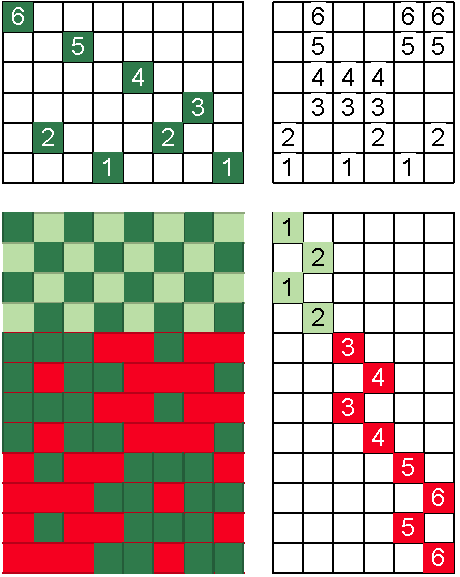Profile Drafts
Marcy Petrini
July, 2021
This month challenge for our on-line study group is to design various unit weaves based on one profile draft.
Profile drafts are a shorthand to list the threading order of blocks. Given the specific threading of each block, the profile draft can then be expanded to the threading draft for the particular sequence.
For example, we have the profile draft below and we want to weave it as a single, two-ties, unpaired structure with a 1:1 ratio, also called summer and winter:
|
B |
B |
|
|
|
|
A |
This can also be expressed as:
A, B, B.
We know that the design has one block of A and two blocks of B. The profile draft would expand to the drawdown below:

I choose to treadle it as single, but that is not specified by the profile draft. However, we generally treadle the number of repeats of the blocks, one repeat for block A, two for block B (note the drawdown is sinking shed).
In general, a block can be treadled using its pattern shafts with each tie down thread. In this example, for block A we have 1 & 3 vs. 2 & 3 (with tabbies in between).
In weaving, of course, we repeat that sequence throughout the fabric, and we would obtain the following cloth:

Given that unit weaves have fixed blocks which can be repeated, and organized in a variety of ways, profile drafts are ideal for designing with this group of weaves. Blocks can be combined in the treadling, adding more to our design possibilities.
I have seen profile drafts used for other weaves, but they can be unclear, as easily illustrated using overshot.
Some people define block A of overshot as:
1, 2
Traditionally, as defined by Mary Black, the block A is:
1, 2, 1, 2
But the threading could be continued, being aware that the supplementary weft float will span the width of the block.
When we come to the A, B, B profile draft, how would we translate it to overshot?
1, 2, 3, 4, 3, 4
Or:
1, 2, 1, 2, 3, 4, 3, 4, 3, 4, 3, 4
There is ambiguity.
But we can use the same profile draft, A, B, B, for other unit weaves easily.
For example, we can use the double, two-ties, unpaired unit weave, with a 1:1 ratio.
From its classification, we can deduce the threading; we also know that the rendition of the structure will require 6 shafts: 2 ties, plus 2 (“double”) pattern shafts per block and we have two blocks, A and B.
Here is the expanded drawdown, treadling the two blocks in the classical way.

Here is a challenge for you:
Assume you have 8 shafts available on your loom. If you don’t, you can still do the challenge because, if you understand a structure, you can design it with any number of shafts. If you have more, feel free to expand to more unit weaves.
Use unit weaves only. The number and arrangement of pattern shafts can be changed, and the number and arrangement of tie-down shafts can be changed, giving lots of options.
Use this profile draft:
|
|
|
|
D |
D |
|
|
|
|
|
|
|
C |
|
|
C |
|
|
|
|
B |
B |
|
|
|
|
B |
B |
|
|
|
|
|
|
|
|
|
|
A |
How many different unit weaves have you discovered?
Happy Weaving!
Marcy
